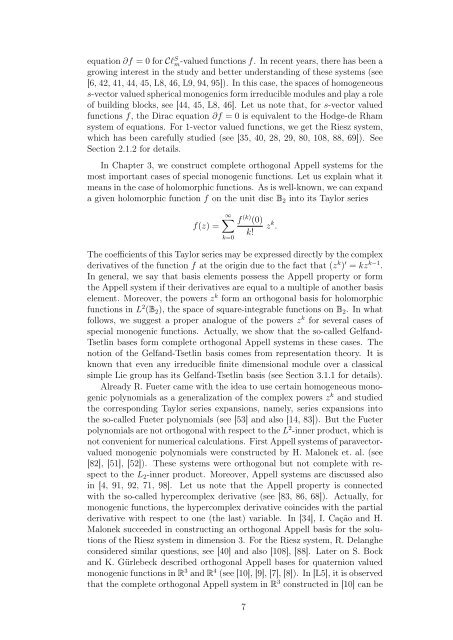Hypercomplex Analysis Selected Topics
Hypercomplex Analysis Selected Topics
Hypercomplex Analysis Selected Topics
You also want an ePaper? Increase the reach of your titles
YUMPU automatically turns print PDFs into web optimized ePapers that Google loves.
equation ∂f = 0 for Cℓ S m-valued functions f. In recent years, there has been a<br />
growing interest in the study and better understanding of these systems (see<br />
[6, 42, 41, 44, 45, L8, 46, L9, 94, 95]). In this case, the spaces of homogeneous<br />
s-vector valued spherical monogenics form irreducible modules and play a role<br />
of building blocks, see [44, 45, L8, 46]. Let us note that, for s-vector valued<br />
functions f, the Dirac equation ∂f = 0 is equivalent to the Hodge-de Rham<br />
system of equations. For 1-vector valued functions, we get the Riesz system,<br />
which has been carefully studied (see [35, 40, 28, 29, 80, 108, 88, 69]). See<br />
Section 2.1.2 for details.<br />
In Chapter 3, we construct complete orthogonal Appell systems for the<br />
most important cases of special monogenic functions. Let us explain what it<br />
means in the case of holomorphic functions. As is well-known, we can expand<br />
a given holomorphic function f on the unit disc B2 into its Taylor series<br />
f(z) =<br />
∞<br />
k=0<br />
f (k) (0)<br />
k!<br />
The coefficients of this Taylor series may be expressed directly by the complex<br />
derivatives of the function f at the origin due to the fact that (z k ) ′ = kz k−1 .<br />
In general, we say that basis elements possess the Appell property or form<br />
the Appell system if their derivatives are equal to a multiple of another basis<br />
element. Moreover, the powers z k form an orthogonal basis for holomorphic<br />
functions in L 2 (B2), the space of square-integrable functions on B2. In what<br />
follows, we suggest a proper analogue of the powers z k for several cases of<br />
special monogenic functions. Actually, we show that the so-called Gelfand-<br />
Tsetlin bases form complete orthogonal Appell systems in these cases. The<br />
notion of the Gelfand-Tsetlin basis comes from representation theory. It is<br />
known that even any irreducible finite dimensional module over a classical<br />
simple Lie group has its Gelfand-Tsetlin basis (see Section 3.1.1 for details).<br />
Already R. Fueter came with the idea to use certain homogeneous monogenic<br />
polynomials as a generalization of the complex powers z k and studied<br />
the corresponding Taylor series expansions, namely, series expansions into<br />
the so-called Fueter polynomials (see [53] and also [14, 83]). But the Fueter<br />
polynomials are not orthogonal with respect to the L 2 -inner product, which is<br />
not convenient for numerical calculations. First Appell systems of paravectorvalued<br />
monogenic polynomials were constructed by H. Malonek et. al. (see<br />
[82], [51], [52]). These systems were orthogonal but not complete with respect<br />
to the L2-inner product. Moreover, Appell systems are discussed also<br />
in [4, 91, 92, 71, 98]. Let us note that the Appell property is connected<br />
with the so-called hypercomplex derivative (see [83, 86, 68]). Actually, for<br />
monogenic functions, the hypercomplex derivative coincides with the partial<br />
derivative with respect to one (the last) variable. In [34], I. Cação and H.<br />
Malonek succeeded in constructing an orthogonal Appell basis for the solutions<br />
of the Riesz system in dimension 3. For the Riesz system, R. Delanghe<br />
considered similar questions, see [40] and also [108], [88]. Later on S. Bock<br />
and K. Gürlebeck described orthogonal Appell bases for quaternion valued<br />
monogenic functions in R 3 and R 4 (see [10], [9], [7], [8]). In [L5], it is observed<br />
that the complete orthogonal Appell system in R 3 constructed in [10] can be<br />
7<br />
z k .

















